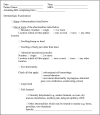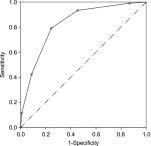Validation of the Pittsburgh Infant Brain Injury Score for Abusive Head Trauma
- PMID: 27338699
- PMCID: PMC4925074
- DOI: 10.1542/peds.2015-3756
Validation of the Pittsburgh Infant Brain Injury Score for Abusive Head Trauma
Abstract
Background: Abusive head trauma is the leading cause of death from physical abuse. Misdiagnosis of abusive head trauma as well as other types of brain abnormalities in infants is common and contributes to increased morbidity and mortality. We previously derived the Pittsburgh Infant Brain Injury Score (PIBIS), a clinical prediction rule to assist physicians deciding which high-risk infants should undergo computed tomography of the head.
Methods: Well-appearing infants 30 to 364 days of age with temperature <38.3°C, no history of trauma, and a symptom associated with an increased risk of having a brain abnormality were eligible for enrollment in this prospective, multicenter clinical prediction rule validation. By using a predefined neuroimaging paradigm, subjects were classified as cases or controls. The sensitivity, specificity, and negative and positive predictive values of the rule for prediction of brain injury were calculated.
Results: A total of 1040 infants were enrolled: 214 cases and 826 controls. The 5-point PIBIS included abnormality on dermatologic examination (2 points), age ≥3.0 months (1 point), head circumference >85th percentile (1 point), and serum hemoglobin <11.2g/dL (1 point). At a score of 2, the sensitivity and specificity for abnormal neuroimaging was 93.3% (95% confidence interval 89.0%-96.3%) and 53% (95% confidence interval 49.3%-57.1%), respectively.
Conclusions: Our data suggest that the PIBIS accurately identifies infants who would benefit from neuroimaging to evaluate for brain injury. An implementation analysis is needed before the PIBIS can be integrated into clinical practice.
Copyright © 2016 by the American Academy of Pediatrics.
Conflict of interest statement
Figures
Comment in
-
Improving Clinical Judgment in Abuse Case Finding.Pediatrics. 2016 Jul;138(1):e20161190. doi: 10.1542/peds.2016-1190. Pediatrics. 2016. PMID: 27338700 Free PMC article. No abstract available.
References
-
- Keenan HT, Runyan DK, Marshall SW, Nocera MA, Merten DF, Sinal SH. A population-based study of inflicted traumatic brain injury in young children. JAMA. 2003;290(5):621–626 - PubMed
-
- Duhaime AC, Christian CW, Rorke LB, Zimmerman RA. Nonaccidental head injury in infants—the “shaken-baby syndrome.” N Engl J Med. 1998;338(25):1822–1829 - PubMed
-
- Parks S, Annest J, Hill A, Karch D. Pediatric Abusive Head Trauma: Recommended Definitions for Public Health Surveillance and Research. Atlanta, GA: Centers for Disease Control and Prevention; 2012
-
- US Department of Health and Human Services , Administration on Children, Youth and Families, Children's Bureau. Child maltreatment 2013. http://www.acf.hhs.gov/programs/cb/research-data-technology/statistics-r.... Published 2015
-
- Shanahan ME, Zolotor AJ, Parrish JW, Barr RG, Runyan DK. National, regional, and state abusive head trauma: application of the CDC algorithm. Pediatrics. 2013;132(6). Available at: www.pediatrics.org/cgi/content/full/132/6/e1546 - PMC - PubMed
Publication types
MeSH terms
Grants and funding
LinkOut - more resources
Full Text Sources
Other Literature Sources



